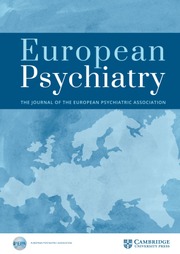Crossref Citations
This article has been cited by the following publications. This list is generated based on data provided by
Crossref.
Bandelow, Borwin
Sojka, Felicita
Broocks, Andreas
Hajak, Göran
Bleich, Stefan
and
Rüther, Eckart
2007.
Trastorno de angustia durante el embarazo y el periodo postparto.
European psychiatry (Ed. Española),
Vol. 14,
Issue. 1,
p.
44.
Vythilingum, Bavanisha
2008.
Anxiety disorders in pregnancy.
Current Psychiatry Reports,
Vol. 10,
Issue. 4,
p.
331.
Martini, Julia
Weidner, Kerstin
and
Hoyer, Jürgen
2008.
Angststörungen in der Schwangerschaft und nach der Geburt:.
Psychosomatik und Konsiliarpsychiatrie,
Vol. 2,
Issue. 4,
p.
207.
Kask, Kristiina
Bäckström, Torbjörn
Gulinello, Maria
and
Sundström-Poromaa, Inger
2008.
Lower levels of prepulse inhibition of startle response in pregnant women compared to postpartum women.
Psychoneuroendocrinology,
Vol. 33,
Issue. 1,
p.
100.
Furber, Christine M.
Garrod, Debbie
Maloney, Eileen
Lovell, Karina
and
McGowan, Linda
2009.
A qualitative study of mild to moderate psychological distress during pregnancy.
International Journal of Nursing Studies,
Vol. 46,
Issue. 5,
p.
669.
Klauke, Benedikt
Deckert, Jürgen
Reif, Andreas
Pauli, Paul
and
Domschke, Katharina
2010.
Life events in panic disorder-an update on “candidate stressors”.
Depression and Anxiety,
Vol. 27,
Issue. 8,
p.
716.
Pearlstein, Teri
and
Star, Jami
2010.
de Swiet's Medical Disorders in Obstetric Practice.
p.
524.
Siervo, Mario
Horta, Bernardo L.
Stephan, Blossom C. M.
Victora, Cesar G.
Wells, Jonathan C. K.
and
Sorensen, Thorkild I. A.
2010.
First-Borns Carry a Higher Metabolic Risk in Early Adulthood: Evidence from a Prospective Cohort Study.
PLoS ONE,
Vol. 5,
Issue. 11,
p.
e13907.
Macbeth, Abbe H.
and
Luine, Victoria N.
2010.
Changes in anxiety and cognition due to reproductive experience: A review of data from rodent and human mothers.
Neuroscience & Biobehavioral Reviews,
Vol. 34,
Issue. 3,
p.
452.
Muzik, Maria
Thelen, Kelsie
and
Rosenblum, Katherine Lisa
2011.
Perinatal depression: detection and treatment.
Neuropsychiatry,
Vol. 1,
Issue. 2,
p.
179.
Stordeur, C.
and
Lejoyeux, M.
2011.
Psychiatrie et grossesse : la mère et l'enfant.
EMC - Obstétrique,
Vol. 6,
Issue. 3,
p.
1.
Uguz, Faruk
Sahingoz, Mine
Sonmez, Erdem Onder
Karsidag, Cagatay
Yuksel, Goksen
Annagur, Bilge Burcak
and
Annagur, Ali
2013.
The effects of maternal major depression, generalized anxiety disorder, and panic disorder on birth weight and gestational age: A comparative study.
Journal of Psychosomatic Research,
Vol. 75,
Issue. 1,
p.
87.
Uguz, Faruk
Sahingoz, Mine
Gungor, Buket
and
Askin, Rustem
2014.
Low-Dose Imipramine for Treatment of Panic Disorder During Pregnancy.
Journal of Clinical Psychopharmacology,
Vol. 34,
Issue. 4,
p.
513.
Green, Sheryl M.
Haber, Erika
Frey, Benicio N.
and
McCabe, Randi E.
2015.
Cognitive-behavioral group treatment for perinatal anxiety: a pilot study.
Archives of Women's Mental Health,
Vol. 18,
Issue. 4,
p.
631.
Bandelow, Borwin
and
Domschke, Katharina
2015.
Anxiety Disorders and Gender.
p.
31.
Goodman, Janice H.
Watson, Grace R.
and
Stubbs, Brendon
2016.
Anxiety disorders in postpartum women: A systematic review and meta-analysis.
Journal of Affective Disorders,
Vol. 203,
Issue. ,
p.
292.
Uguz, Faruk
Aydin, Adem
Ak, Mehmet
and
Turgut, Keziban
2016.
Low-Dose Imipramine for the Treatment of Panic Disorder During Postpartum Period.
Journal of Clinical Psychopharmacology,
Vol. 36,
Issue. 3,
p.
292.
Uguz, Faruk
2016.
A pharmacological approach to panic disorder during pregnancy.
The Journal of Maternal-Fetal & Neonatal Medicine,
Vol. 29,
Issue. 9,
p.
1468.
Wisner, Katherine L.
Sit, Dorothy K.Y.
Bogen, Debra L.
Altemus, Margaret
Pearlstein, Teri B.
Svikis, Dace S.
Misra, Dawn
and
Miller, Emily S.
2017.
Obstetrics: Normal and Problem Pregnancies.
p.
1147.
Uguz, Faruk
Yuksel, Goksen
Onur, Ozge Sahmelikoglu
Karsidag, Cagatay
Gezginc, Kazim
and
Arpaci, Nazile
2018.
Neonatal outcomes in pregnant women with untreated and treated panic disorder.
Comprehensive Psychiatry,
Vol. 87,
Issue. ,
p.
107.



Comments
No Comments have been published for this article.